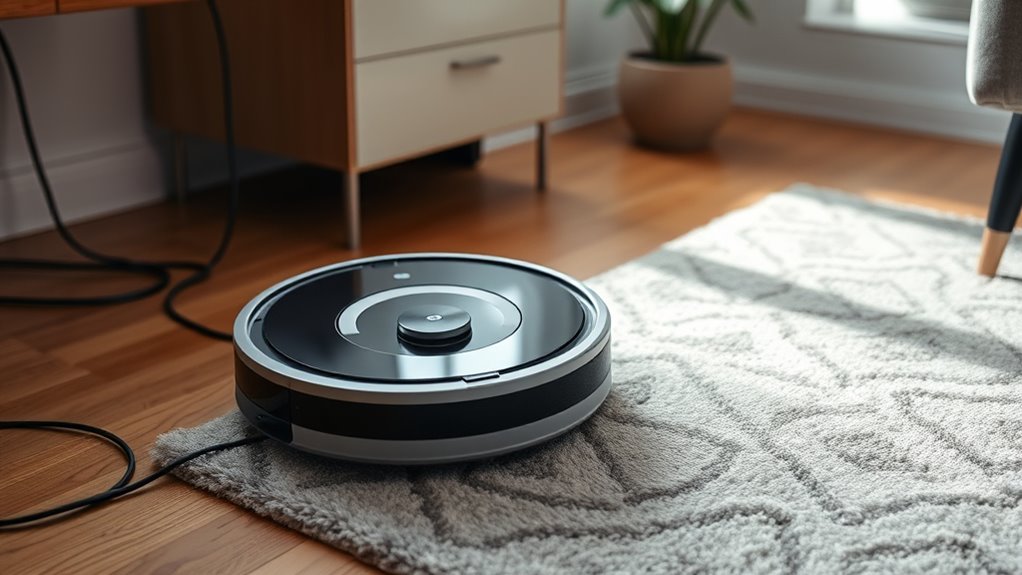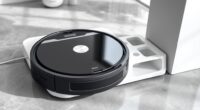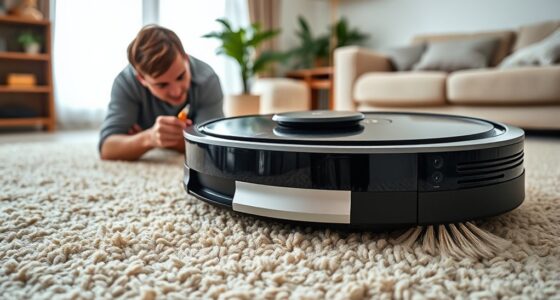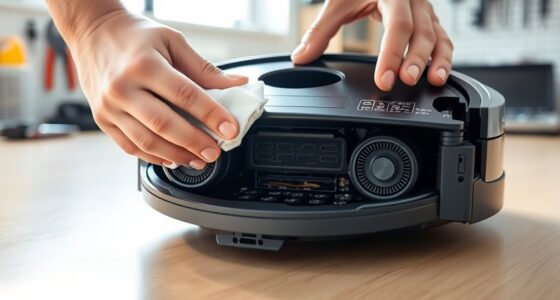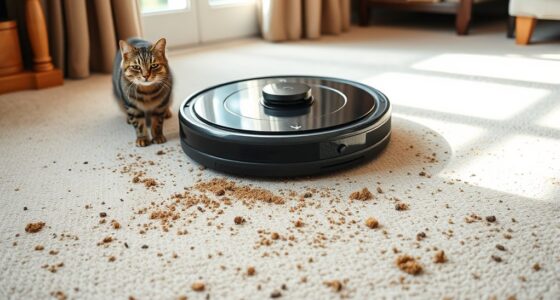To keep your pets safe and prevent your robot vacuum from getting stuck, make certain obstacle detection sensors are clean and calibrated regularly. Use boundary strips or virtual barriers to block stairs and fragile areas. Clear clutter, toys, and cords before each use, and pay attention to pet zones like beds and food bowls. Keeping sensors unobstructed and updating firmware boosts safety features. For detailed tips on optimizing your vacuum’s safety measures, you’ll find helpful insights as you explore further.
Key Takeaways
- Regularly clean and calibrate cliff sensors to ensure accurate fall detection.
- Use boundary strips or virtual barriers to prevent the vacuum from accessing fall-prone areas.
- Keep sensor areas free of dust, debris, and obstructions for reliable obstacle and cliff detection.
- Clear the area of small objects and cords to prevent the vacuum from getting stuck.
- Update firmware regularly to improve obstacle avoidance and fall prevention features.
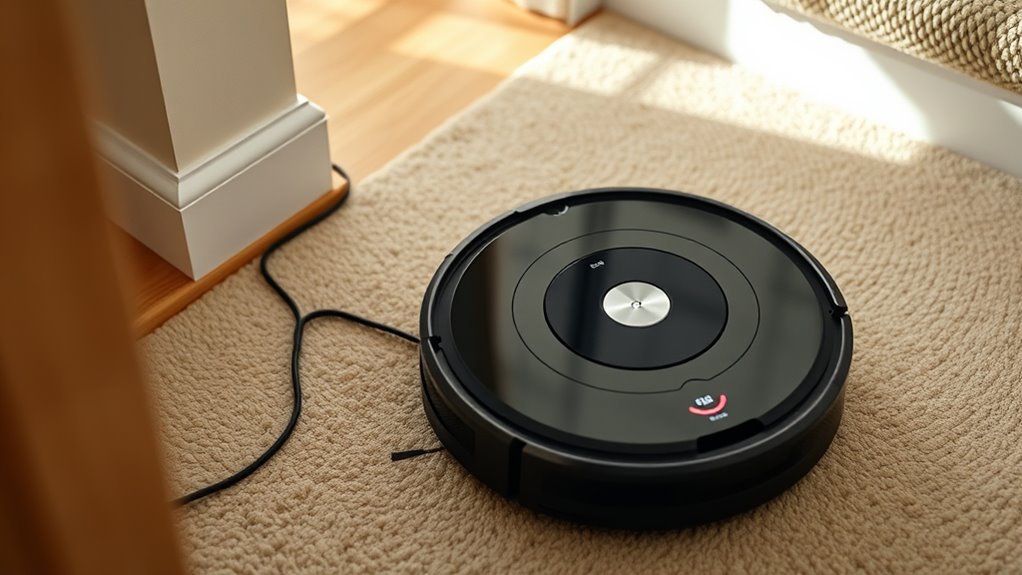
Robot vacuums have become a popular convenience, but understanding how to use them safely is essential. When it comes to pet safety, you want to make sure your furry friends are protected from any accidents or injuries. Many robot vacuums are equipped with obstacle detection technology, which helps them navigate around objects, including pets. This feature is crucial for preventing collisions or injuries, especially if your pet tends to move quickly or suddenly change direction. Before starting the vacuum, clear the area of any toys, cords, or other small objects that could confuse the obstacle detection sensors or cause the robot to get stuck. This simple step reduces the risk of damage to your belongings and keeps your pets safe.
You should also pay close attention to the placement of pet beds, food bowls, and litter boxes. These are often areas where pets spend a lot of time, and they can be tricky for robot vacuums to navigate. Many models have sensors that detect larger objects and prevent the vacuum from bumping into them, but they aren’t foolproof. Regularly checking these zones can help prevent your pet from becoming frightened or injured if the vacuum unexpectedly bumps into them. Additionally, some robot vacuums feature a ‘no-go’ zone setting, which allows you to designate certain areas as off-limits. Use these features to keep the vacuum away from pet areas where you don’t want it to go, protecting your pets from unnecessary stress or accidents.
Obstacle detection also plays a *crucial* role in avoiding falls, especially if you have stairs or uneven surfaces. Modern robot vacuums come with cliff sensors that detect drops and prevent the vacuum from falling down stairs or off ledges. Make sure these sensors are clean and unobstructed so they can function properly. If your home has areas prone to falls, consider using boundary strips or virtual barriers to keep the robot confined to safe zones. Regularly updating your vacuum’s firmware can also improve obstacle detection and cliff sensors, ensuring your pet’s safety and preventing the vacuum from getting stuck or falling. Additionally, sensor calibration can optimize the vacuum’s ability to detect obstacles and edges more accurately.
Frequently Asked Questions
How Do Robot Vacuums Detect Stairs and Ledges?
To detect stairs and ledges, your robot vacuum uses sensor calibration and obstacle recognition. It relies on cliff sensors, which emit infrared signals to measure drop-offs. When the sensors detect a sudden change in distance, the vacuum recognizes a ledge or stair. This allows it to adjust its movement, preventing falls and stuck situations. Regularly calibrating sensors guarantees these safety features work effectively, keeping your floors clean without accidents.
Can Robot Vacuums Cause Damage to Pets or Children?
You might worry that robot vacuums could harm pets or children, but they’re designed with safety in mind. Modern models often include sensors to avoid obstacles, reducing the risk of injury. While no device is completely risk-free, choosing a vacuum with pet safety and child safety features helps protect your loved ones. Always supervise during initial use and keep small children and pets away from the vacuum during operation for added peace of mind.
What Maintenance Is Needed to Keep Safety Features Effective?
To keep your robot vacuum’s safety features effective, you should regularly check its battery health and replace it if it’s degraded. Also, guarantee sensor calibration is up to date—clean sensors gently and recalibrate if your vacuum detects obstacles improperly. Regular maintenance like clearing debris from sensors and updating software helps prevent falls and stuck bots, ensuring your device operates safely around pets and children.
Are There Specific Brands With Better Safety Records?
When choosing a robot vacuum, you wonder if some brands have better safety records. You should look for brands known for high brand reliability and safety certifications, which indicate they meet industry standards. These brands often incorporate advanced safety features like cliff sensors and obstacle detection, reducing risks of falls or getting stuck. Doing your research helps guarantee you select a model that prioritizes safety and minimizes potential hazards in your home.
How Do I Troubleshoot if My Robot Gets Stuck Frequently?
If your robot vacuum keeps getting stuck like it’s trying to conquer Mount Everest, don’t panic! First, check if the sensors need calibration—sometimes dust or smudges can confuse them. Then, enhance obstacle recognition by clearing clutter and marking tricky spots. Regularly clean sensors and update the firmware. These simple steps will make your bot glide smoothly, avoiding those frustrating hang-ups like a pro!
Conclusion
Just like Icarus warned us about flying too close to the sun, you should stay vigilant with your robot vacuum. By setting boundaries, clearing obstacles, and monitoring its path, you guarantee your smart helper doesn’t stumble into trouble. Think of it as guiding your own Daedalus—crafting a safe path that keeps your bot grounded and your home accident-free. With these precautions, your robot will soar through chores, not fall into hazards.
